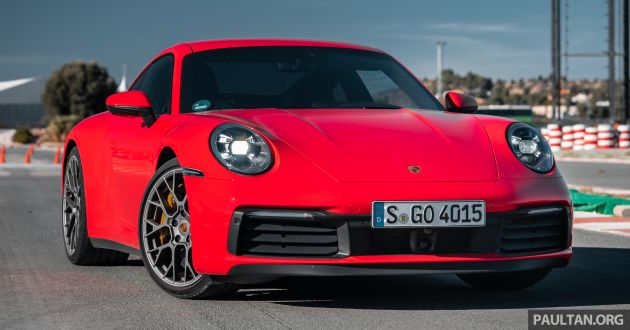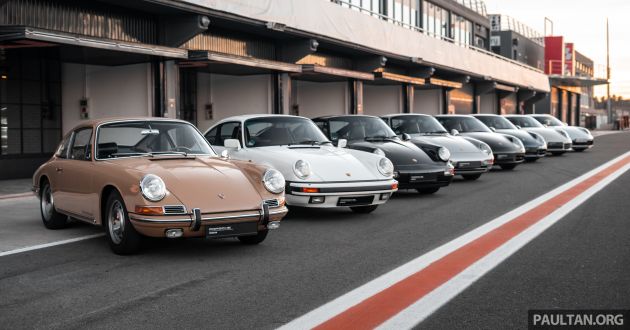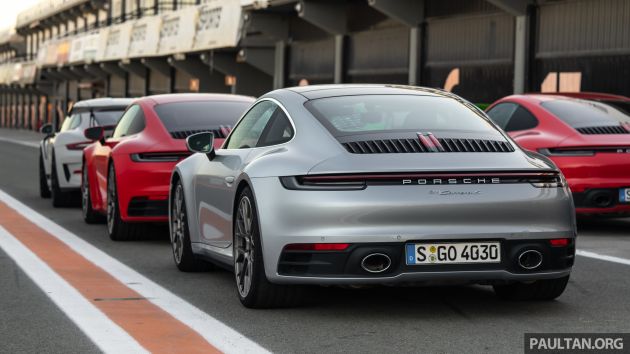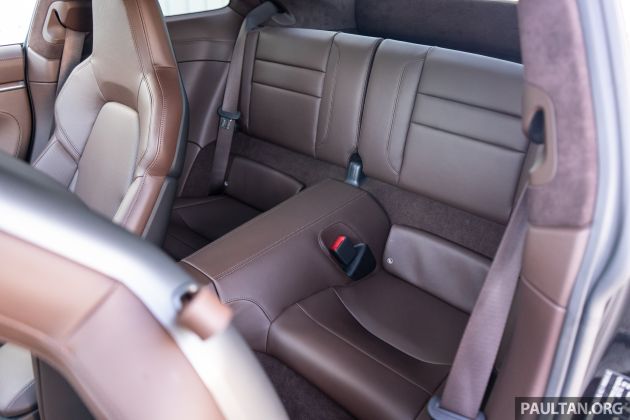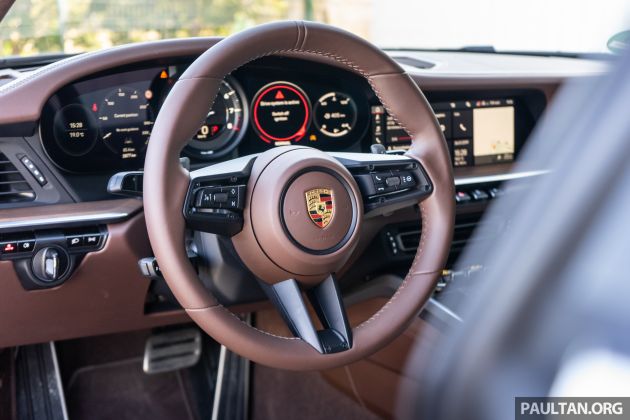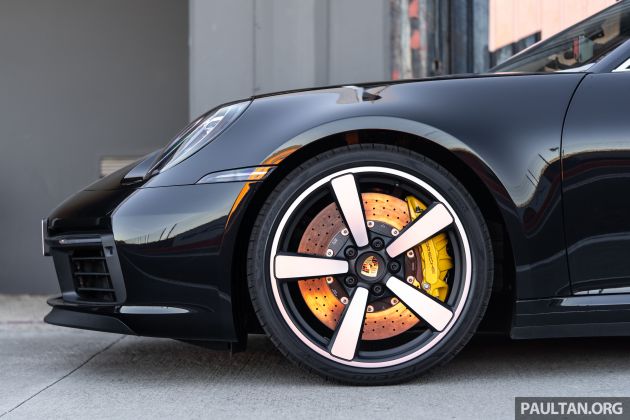Some of the world’s most celebrated individuals are school dropouts. Steve Jobs, Bill Gates, Ellen DeGeneres and Mark Zuckerberg are some of today’s most distinguished examples. But did you know that the person responsible for designing the Porsche 911 was also a dropout? Well, he actually got kicked out of design school, so it’s one the same.
Ferdinand Alexander Porsche, more affectionately known as Butzi, was his name. After his expulsion, Butzi – then in his 20s – worked for his grandfather Ferdinand Porsche and was rubbing shoulders with then hotshot design director for Volkswagen and Porsche, Erwin Komenda. That tutelage didn’t go too well for him either, so they parted ways. Butzi holed up in the adjacent body shop and immediately started working on the 911.
It’s been 56 years since the original Porsche 911 broke cover. After eight iterations, it remains as one of the world’s most endearing sports cars, and possibly among the very few to still use a rear-engine layout. Prioritising tradition has always been one of the automaker’s key mantras, and the 911 is unequivocally its torchbearer.
From a design standpoint, the 992-generation Porsche 911 remains unmistakably recognisable, like all the models that precede it. While the exterior styling seems familiar, everything else underneath is 95% new. So yes, you’re looking at an entirely new Porsche 911.
Essentially, the front and rear design of the car have been modelled after the automaker’s latest styling direction, which comprise of the four-point LED headlights (the top LED matrix headlights feature 84 individual LEDs), wide air intakes, and the continuous rear LED bar.
Speaking of which, the body is considerably wider than the 991 model it replaces – the 992 is a staggering 45 mm wider up front. We’re told that it’s a deliberate design decision (influenced in part by the new chassis) to emphasise the bulging rear arches, and this combination helps accentuate the tapered midsection.
This widebody look is now standard for all models including the Carrera 2. Traditionally, rear-wheel drive 911s feature a narrower rump, but many 911 owners prefer the swelled haunches. There’s also an adaptive rear spoiler with a 25% larger surface area, which supports charge air cooling to prevent loss in performance.
Even before stepping into the car, the 992’s shell features a number of firsts for the model, such as the pop-up door handles, vertical third brake lights that take the form of a pause symbol (which I’m unusually fond of), and a more rigid all-aluminium body. Mixed tyre width is also applied for the first time – the front gets shod with 20-inch wheels, and the rear gets fatter 21-inch hoops.
Inside is where things get a bit more snazzy. Here, the cabin feels like the end result of zealous over-engineering. Materials are soft to the touch for most surfaces – there’s ample use of leather, and our test unit had matching burgundy suede headlining and floor mats. Am I really in a 911?
As if that wasn’t enough, the driver now gets a cleaner, more sophisticated cockpit, featuring two seven-inch digital instrument displays that flank the analogue rev counter in the middle. Together, they form the iconic five-dial setup that’s graced by every other 911 in existence. Next to that is a high-resolution 10.9-inch touchscreen display for the Porsche Communication Management, below which rests a row of five retro-styled switches.
The centre tunnel is also entirely new, and gone is the good ol’ stick. In its place is a mini electronic shifter that’s super intuitive to operate – flick up to reverse, down to drive. Easy peasy. Purists though, may find this modern approach slightly offensive. There’s no manual version for now, but perhaps in the near future.
The redesigned seats collectively shave three kg off the car – they are plonked five millimetres lower than before – and offer better lateral and shoulder support. In short, build quality is absolutely on point, and the cabin is a work of art, by far the best in a 911. This reinforces the notion of it being an all-purpose driving machine. But is it any better to drive than before?
Well, the experience starts at the turn of the key. Like the 991.2, base models get the turbocharged 3.0 litre horizontally-opposed six-cylinder petrol engine. While displacement is the same as before, the engine is new for the most part, featuring larger symmetrical turbochargers and a brand new intercooler. Piezo injectors are used for the first time, allowing improved responsiveness and revving characteristic.
As one of the world’s last few remaining devotees to the Boxer engine, one has to appreciate the distinctive acoustic rumble it makes. The optional Porsche Sports Exhaust system amplifies this addictive trait, and unless you’re crazy (like those who claim that a flat-six engine is simply a V6 with a 180-degree opening), you’d have it specified right from the get-go, even before you choose the colour of your car.
In Carrera S form, the engine makes 450 PS at 6,500 rpm and 530 Nm of torque at 2,300 to 5,000 rpm, or 30 hp and 30 Nm more than the 991.2 Carrera S. That’s more than enough for most drivers’ needs – the 992, now equipped with a new fast-shifting eight-speed PDK, rockets from standstill to 100 km/h in just 3.7 seconds, or 3.5 seconds with the optional Sports Chrono Pack.
The extra cog (the 991 has a seven-speed PDK) allows for a wider spread of ratios, and there’s an obvious sense of linearity and responsiveness during in-gear accelerations. This is in part due to the larger 48 mm turbochargers, which are mirrored and rotate in opposing directions. This improves air flow, with a maximum boost pressure of 1.2 bar.
Gearshifts are lightning quick, as you’d expect from the world-renowned PDK, and imperceptibly slick as well. All eight ratios are new, with the first gear shorter and eighth longer, allowing for a longer final-drive ratio. Also, the 306 km/h V-max can be achieved in sixth gear, and all things considered, there’s absolutely no way of faulting the eight-speed PDK. World-class stuff, this.
Barreling down Circuit Ricardo Tormo (otherwise known as Circuit de Valencia) in the C2S showcased increased stability and balance, two traits that further distance itself from the ominous widow-making reputation its predecessors were infamously known for.
There are two things that proved key to achieving this, the first being the wider tracks – the front tracks are wider by 46 mm, and the rear is pushed out by 39 mm. The other thing is that the entire powertrain assembly is moved forwards by 20 mm. Don’t worry, loyalists, the engine still hangs over the rear axle.
The 992 also gets stiffer springs and uprated anti-roll bars to combat lateral forces – the net effect of this is a less tail-happy RR sports car, though the small downside to this is that the drive becomes a tad more predictable.
You could still go sideways with PSM (Porsche Stability Management) turned off, but unfortunately we weren’t permitted to disable the life-saving system. What’s clear is that the 911 Carrera S is not as focused a machine as the 718 Cayman GTS, but what it lacks in the drive is made up for with the sublime cabin. Plus, the 911 still seats four.
As for the C4S, its all-wheel drive system also gets upgraded with a new clutch and differential unit. They are water-cooled and strengthened to cope with the higher engine output, and the car is inherently less twitchy when cornering, especially when gunning the throttle on exits.
There’s a discernible deftness to the steering as well. Porsche says the steering rack on the 992 is 11% quicker than before, while models with the optional rear-wheel steering are 6% more direct. One thing’s for sure, the steering feels keener on the turn-ins than the 991 C4S.
Typically in a RWD car, you’d want the tail to swing wide when prompted. But to avoid wrapping the car around a tree on a rainy day, Porsche develop Wet Mode, otherwise known as the world’s first wetness recognition programme. This works by using acoustic sensors in the front wheel well to recognise spray patterns while driving, and this helps the system determine the amount of water present on the driven surface.
The process is swift, and upon detection, the driver will be prompted to manually switch to Wet Mode. When activated, PSM and PTM (Porsche Traction Management) work in unison to prevent the car from swapping ends. We exhaustively tried pushing the C2S wide on a designated wet surface as best as we could, but the second slippage is detected, power gets cut and the ABS system springs into action. It’s a weird sensation, but like it or not, it’s going to be available across the new 911 range.
On the track, the new Carrera S has shown its mettle – it’s got a sharper front end, a more stable tail, and a decidedly more pliable powertrain. Power is available on demand, no matter the speed or gear it’s in. But at the end of the day, the 911 is not all about track days, and the three million odd kilometres the prototype vehicles have gone through covers just about every driving scenario imaginable.
For city dwellers with a penchant for spirited drives along scenic routes, the 911 is just the kind of car Porsche makes for you. It’s like a Swiss Army knife, an all-in-one package that includes all things necessary and omits the redundant. Except now, the new 911 feels infinitely more luxurious than ever before.
It rides better as well, thanks to a set of fully re-engineered adaptive dampers (Porsche Active Suspension Management). This suspension is standard and has been upgraded on both the hardware and software side of things, so it’s more comfortable and, conversely, sportier. If it’s not firm enough, there’s PASM sports chassis, which lowers ride height by 10 mm.
The brakes bite more precisely, which makes brake modulation seamlessly intuitive and confidence-inspiring. This is achieved by shortening the brake pedal ratio and the employment of an electric brake booster, which replaces the older pneumatic booster.
Since the rear wheels are now bigger and can accommodate larger discs, the rotor size is up by 20 mm to 350 mm, yet each weigh 300 grammes less than before thanks to new compounds. For track junkies, there’s the optional Porsche Ceramic Composite Brake that’s even lighter and doesn’t fade.
To add salt to injury (die-hard purists would have considered forsaking the 992 by now), the 911 can be specified with a number of driver assistance systems. This includes autonomous emergency braking (AEB), adaptive cruise control with stop-go function, lane keeping assist with traffic sign recognition, lane change assist, park assist with 360-degree view and night vision assist with thermal imaging. Blasphemy, I hear you say?
Well, as with many things, change is inevitable. As Zuffenhausen’s crown jewel, the 911 will continue to evolve unapologetically, and in the case of the 992, that change is for the better. In short, the Carrera S is many times more than good enough for most 911 virgins.
Objectively, the 718 Boxster and Cayman would be the obvious driver’s choice, but the charm in which the 911 radiates is second to none. With over a million collective units sold, it’s impossible to overlook the colossal cult movement a design school dropout instituted 56 years ago. If special is what you’re looking for, then there’s none out there with the legacy to match the Porsche 911. Also, stay in school, yeah?
Source: Read Full Article

